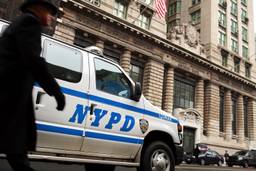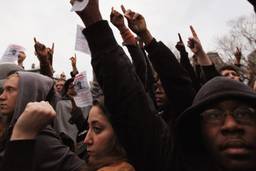December 12 marked another day of nationally coordinated actions meant to disrupt the flow of what Occupy Wall Street protesters perceive to be a corrupt financial system that serves only the upper-one percent. The idea was to interrupt shipping at some major West Coast ports with the specific aim being to damage the profitability of Goldman Sachs Group Inc, which owns a stake in the largest cargo-terminal operator.
By targeting ports, protesters angered some workers who perceive the action as being detrimental to the 99 percent rather than CEOs.
“I just lost $400 today,” said Mark Hebert, a long-haul trucker for Salt Lake City-based C.R. England Inc., who was stranded in Oakland with 36,000 pounds of Kansas beef bound for Asia. “These people say they represent the 99 percent. They don’t represent me.”
I saw such gripes published many times throughout yesterday, and yet no where did I see a proposal about where exactly along the chain of Capitalism protesters should commit direct action. Surely, if they occupied the factories producing the merchandise in America (whatever hasn’t been outsourced overseas yet,) they’d be arrested for trespassing. Activists can’t even get close to the financial district, since police barricade Wall Street like its Fort Knox, so occupying the trading floor is out of the question.
CEOs, surrounded by armies of private security, not to mention public security in the shape of police officers working at the behest of JPMorgan Chase, aren’t likely to agree to a sit-down meeting with occupiers to hear their demands. That leaves few other options, one of those being protesting at ports.
Well, ports, and also outside of Goldman Sachs, which is where hundreds of protesters gathered yesterday in New York City before NYPD arrested 17 of them. The group marched from Goldman Sachs to the Winter Garden Atrium near Ground Zero before they were arrested and charged with trespassing and disorderly conduct. The atrium, like Zuccotti Park, is owed by Brookfield Properties. Protesters formed a ring inside the atrium and chanted, “Occupy Brookfield!” before the arrests started.
Many of the 17 individuals arrested were independent/citizen journalists who were trying to film police actions, including John Knefel, an independent journalist whose work has appeared in Salon.
Knefel was thrown to the ground and arrested for, in the words of his sister Molly, “trying to film police.” She managed to take a photo of her brother being arrested before he was dragged away by police.

Concerned about her brother, she approached an officer to ask him why Knefel had been arrested, to which the officer told her to step back.
“I have a gun on me, okay? I don’t need people coming that close to me,” the officer said.
When she asked another officer why he mentioned his gun, the other officer replied, “he shouldn’t have said that.” (The moment occurs at 9:08)
From the back of the paddy wagon, Knefel tweeted that many of those arrested were citizen journalists. “None of us have official credentials, just lots of Indy journos & citizens w cameras,” he wrote.
In total, 33 journalists have been arrested at Occupy events.
As of the filing of this report, Knefel has been held in jail for about 24 hours, which is not an unprecedented detention time for independent journalists who find themselves snatched up and detained for the crime of not having official city-approved press credentials.
Police arrested protesters in several states where port actions took place. In Houston, 20 occupiers were arrested, along with two protesters in Portland and 11 more in Seattle. It’s ironic that the most arrests took place in Houston given that the occupiers there took the least extreme position on the day of action, deciding to hold a solidarity event instead of a full occupation.
“We are here in solidarity with the West Coast port shutdowns, but we’re not here to shut down the port,” said Amy Price, an Occupy Houston protester. “We don’t want the Houston port workers to lose money. We just want to cause enough havoc to draw a spotlight on what’s going on with our port. And the way to do that, we think, is civil disobedience.”
Regardless, 60 members of the Houston Police Department, Harris County Sheriff’s Office and the Houston Fire Department turned out to closely monitor the demonstration, the Houston Chronicle reports.
When activists laid on the street in order to block the entrance to the port, police began arresting protesters and charged them with blocking a public roadway. Eight where charged with using a “criminal instrument” (PVC pipes) to block a public roadway.
It was strange to see a large police response for such relatively tame acts of civil disobedience, but that’s become a theme of Occupy Wall Street. The 30:1 police-to-protester ratio is a familiar theme of these kinds of protests, but only, of course, if the protest target has something to do with the financial district in New York City or major companies’ import-export practices. When activists in New York City chose East New York as the site of their protest, very few police officers turned out to monitor the event. Those who did show up allowed protesters to march down the middle of the street, disrupt traffic, and block the roadways outside of homes.
If Occupiers attempted similar behavior in the financial district, police would arrest them en masse. That’s not mere speculation. That exact scenario occurs every time protesters stray into Manhattan streets, and I’ve personally witnesses an NYPD officer tear the press pass off a foreign cameraman’s neck when he went into the street to film police activity.
It almost seems as though there are parallel police manuals: one for how to protect the rich and the other detailing how to deal with the poor.




